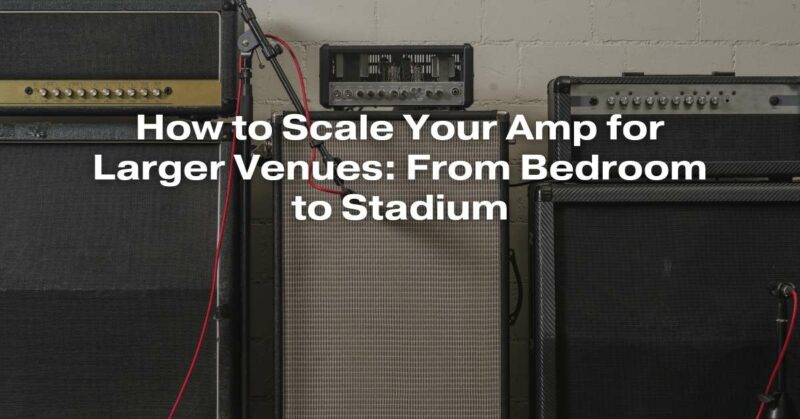Scaling your amplifier setup for larger venues is a crucial step in the journey of a musician. While practicing in your bedroom or playing small gigs at local bars is a great way to start, there comes a point where you need to amplify your sound to fill larger spaces. Whether you’re dreaming of performing in a stadium or just moving up to larger clubs and theaters, scaling your amp setup is essential for delivering a professional and impactful performance. In this comprehensive guide, we’ll walk you through the steps to scale your amp setup for larger venues, taking you from the cozy confines of your bedroom to the grandeur of a stadium stage.
Assess Your Current Setup
Before diving into the world of larger venues, it’s essential to assess your current setup. This evaluation will help you understand what aspects of your rig need upgrading and what you can retain. Here are some factors to consider:
1. Amplifier Size and Power
Take a close look at your current amplifier. Is it powerful enough to provide the volume and clarity needed for larger venues? Smaller practice amps are suitable for bedroom practice but won’t cut it in bigger spaces. Look for a high-wattage amplifier with enough headroom to fill a larger room without distortion.
2. Speaker Cabinet
The speaker cabinet you use is equally important. Smaller cabinets may not project sound adequately in larger venues. Consider investing in a larger cabinet with multiple speakers to distribute sound effectively.
3. Sound Quality
Listen critically to the sound your current setup produces. Are you satisfied with the tone and clarity? Larger venues can accentuate imperfections in your tone, so it’s crucial to fine-tune your sound for optimal performance.
4. Effects and Pedals
Evaluate your pedalboard and effects. Ensure that you have the necessary tools to shape your sound effectively. Larger venues may require more extensive effects to create ambiance and texture.
Upgrading Your Amp and Gear
Now that you’ve assessed your current setup, it’s time to upgrade your gear for larger venues.
5. Choose the Right Amp
Selecting the right amplifier is the most critical step in scaling your setup. Consider these factors:
- Wattage: Look for an amplifier with sufficient wattage to fill the venue. For small clubs, 30-50 watts may suffice, but for larger venues, 100 watts or more is often necessary.
- Versatility: Opt for an amp with multiple channels and settings to adapt to different playing situations.
- Portability: While larger venues demand more power, you’ll still want an amp that’s manageable to transport. Many modern high-wattage amps are designed with portability in mind.
6. Upgrade Your Speaker Cabinet
A high-quality speaker cabinet is essential for projecting your sound effectively. Choose a cabinet with multiple speakers and the appropriate wattage handling capacity. Consider options with adjustable impedance settings to match your amp’s requirements.
7. Fine-Tune Your Sound
Work on perfecting your tone. Experiment with different types of pickups, strings, and pedals to achieve the desired sound for larger venues. It’s also crucial to consider the acoustics of the venue and adjust your tone accordingly.
8. Invest in Professional Pedals and Effects
Larger venues often require a more expansive sonic palette. Invest in professional-grade effects pedals to add depth and texture to your sound. Delays, reverbs, and modulation effects can enhance your performance and make your music more engaging in larger spaces.
Preparing for Live Sound Reinforcement
In larger venues, sound reinforcement becomes a crucial aspect of your performance. You’ll likely need to work with a sound engineer or handle the sound yourself. Here’s what you need to know:
9. Microphones and Mic Placement
Choose the right microphones for your instruments and vocals. Experiment with microphone placement to capture the best sound. Dynamic microphones are often preferred for live performances due to their durability and feedback rejection.
10. Monitor System
In larger venues, you might not be able to hear your own playing without a monitor system. Invest in high-quality in-ear monitors or stage wedges to ensure you can hear yourself and your bandmates clearly.
11. Soundcheck
Allocate ample time for soundchecks before your performance. Work closely with the sound engineer to dial in your tone and ensure everything sounds as intended.
Performance Tips for Larger Venues
Once you have scaled your amp setup and are ready to take on larger venues, here are some performance tips to keep in mind:
12. Stage Presence
Larger stages demand a more significant stage presence. Move around, engage with the audience, and use the space to your advantage. Your energy and interaction with the crowd will enhance the overall experience.
13. Control Feedback
Larger venues can be prone to feedback issues. Learn how to control feedback by positioning yourself correctly in relation to the microphones and using noise gates or feedback suppressors if necessary.
14. Engage with the Sound Engineer
Establish good communication with the sound engineer. They can help you achieve the best sound in the venue. Be clear about your sound preferences and any specific effects you want to use during the performance.
15. Be Prepared for Technical Issues
In larger venues, technical issues can occur. Have backup gear, such as spare cables, strings, and even a backup amplifier, ready in case of emergencies. It’s also helpful to know how to troubleshoot common issues on stage.
Conclusion
Scaling your amp setup for larger venues is an exciting but challenging endeavor for any musician. It requires careful consideration of your gear, sound reinforcement, and performance techniques. By selecting the right amplifier, upgrading your gear, and preparing for live sound reinforcement, you can confidently make the leap from bedroom practice to the grand stage of a stadium. With dedication and perseverance, your music can reach and resonate with audiences on a much larger scale.


